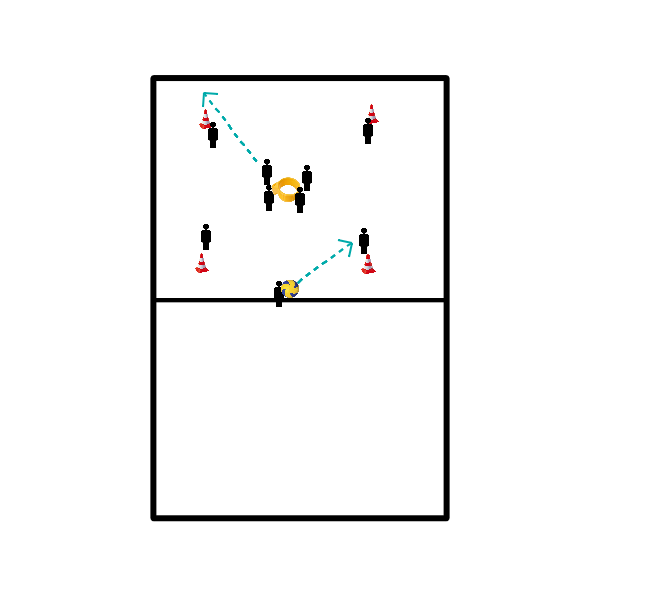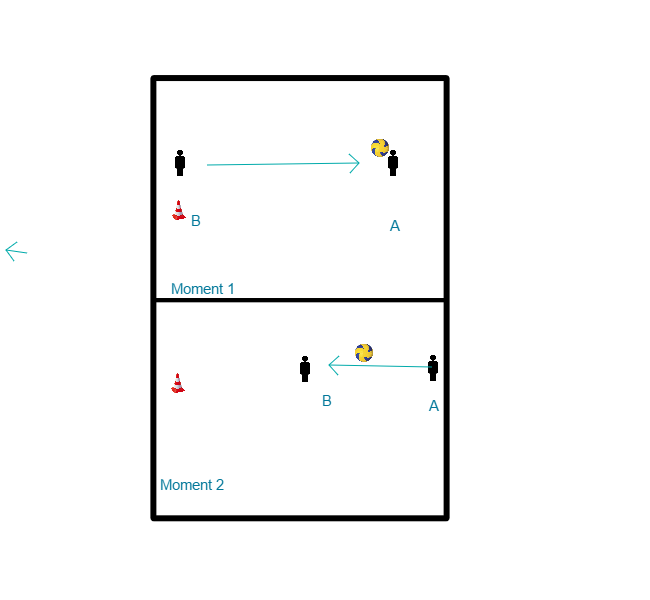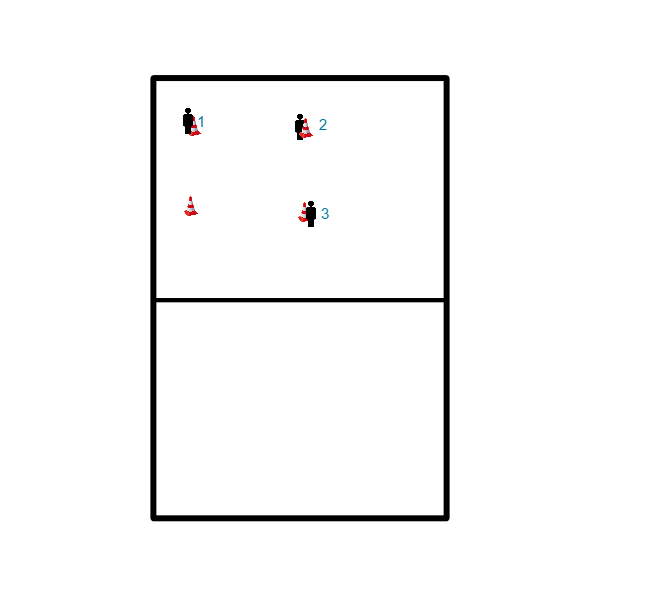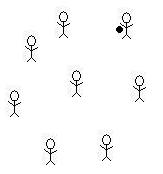Korfball drills for technique passing / attack
1 pole, 1 ball, 4 hats in a square and 9 playersThe
4 attackers stand in a square (near the hats) around the basket, the 4 defenders hold the pole with one hand. The 9th person (the declarer) stands with the ball outside the square of the hats. The attacker passes the ball to one of the attackers, the defender who stands opposite the attacker who receives the ball must run around the hat and the attackers must now score as quickly as possible. If all goes well, the attackers quickly find the person who is free, as one of the defenders has to run around the hat-trick

You make a square, in it stands an attacker, the attacker must keep moving in the square while a defender walks by. One person always plays the ball. The defender looks at the ball and tries to catch it. Every time the attacker catches the ball, someone else runs into the box. When the defender catches the ball, he throws it back and you try again.
 2 teams. Per pair 1 ball and 1 pawn. Player A stays on his spot. Player B starts with the pawn, which is about 10 meters away. Player B runs to player A. Player A throws (with 1 hand) the ball to player B. Player B keeps running until he has caught the ball and then stops. B throws the ball back and runs to the pawn to start the exercise again. after 10x change.
2 teams. Per pair 1 ball and 1 pawn. Player A stays on his spot. Player B starts with the pawn, which is about 10 meters away. Player B runs to player A. Player A throws (with 1 hand) the ball to player B. Player B keeps running until he has caught the ball and then stops. B throws the ball back and runs to the pawn to start the exercise again. after 10x change.
 In short:
In short:
A trio has to pass the ball to each other in a square.That's tricky yes, because one is always missing....
Organisation:
Three players stand in an imaginary square about eight metres from each other. One corner remains unoccupied. The middle player (number 2) of the three has the ball.
You put up three poles in a triangle, in the middle of the three poles you put a pawn. Three children are placed as attackers and the other children stand near the pawns.
First, you can choose that the attackers have to run through the poles. It doesn't matter which pole they hit, they can hit the same pole twice in a row. You can choose for this, so they have to run a lot. Also the children have to score 2 times, the person who scores first can trade with a declarator, the other children can trade with a declarator.
After that you can choose to letthe children do free balls, penalty throws, foul balls etc.
Everyone stands in a circle. One person is the loafer and stands in the circle. Everyone is going to throw the ball over, but the dummy has to try to take the ball away from him. The person with the ball can do this by intercepting the ball or by tapping the person who is holding the ball. When the lummel has taken the ball away, the lummel changes to the next player.

You make a square, in it stands an attacker, the attacker must keep moving in the square while a defender walks by. 1 person always plays the ball. The defender looks at the ball and tries to catch it. Every time the attacker catches the ball, someone else comes into the box. When the defender catches the ball, he throws it back and you try again.
You make a square, in it stands an attacker, the attacker must keep moving in the square while a defender walks by. 1 person always plays the ball. The defender looks at the ball and tries to catch it. Every time the attacker catches the ball, someone else comes into the box. When the defender catches the ball, he throws it back and you try again.
Organisation:
Put 4 poles in a square, about 8 metres apart. In the middle of that square, place 4 pawns in a square, about 2 metres apart.
Four children stand under the basket and the others take three minutes to play pass-backs. Every time they have done that, they walk back to the middle and search for another basket.
After those 3 minutes, the attackers change.
Who will get the most in the 3 minutes?
Attention:
the pace must be high!
Prior to the technique of the penalty throw (the eventual ball) is the run. This
This is done with the hopping step.
Walk in a line from 6 to 7 metres towards the basket and continue until you receive the ball.
Pass the ball to the receiver.
Start the hop, keeping the ball close to your belly.
Hunk, arms bent slightly, step.
Hold the ball straight in front of your body at belly height.
Straighten your body and look at the basket, raise your knee and stretch your arms.
Keep your body nice and straight in relation to the basket.
Let go of the highest point, stretch the body, come down with the other foot and check the ball, keep walking and do not jump.
Stand still after releasing the ball.
You finish the ball past the basket.
Set up two poles facing each other at about 7 meters. The player with the ball stands to the right of the pole, the player without the ball stands to the left of the pole about 1.5 meters in front of the pole. The person with the ball throws to the person without the ball and makes a pass ball. After every pass ball there is a change of roles.
The following run through ball exercise combines practice of the run through ball with fitness training.
The exercise is done on 1 basket, with 4 players and 2 balls. Two players stand under the basket without the ball, one player left in front of the basket with the ball and one player right in front of the basket with the ball.
Player 1 walks up to the middle. He or she chooses a side and gets the ball. Splitter 1 plays the ball inside and makes a through ball. The attacker catches the ball, and fills the empty spot. The person in front without the ball runs through the middle to the basket, and the exercise starts again.
When the exercise is clear, you can choose to make it more about speed. If you choose to do this, the player who throws the ball from the front to the ascending player goes after his ball, and as soon as he or she is in the middle, he or she runs after the person who throws the through ball. As soon as the latter has taken his through ball, the new person runs up and the exercise begins again.







